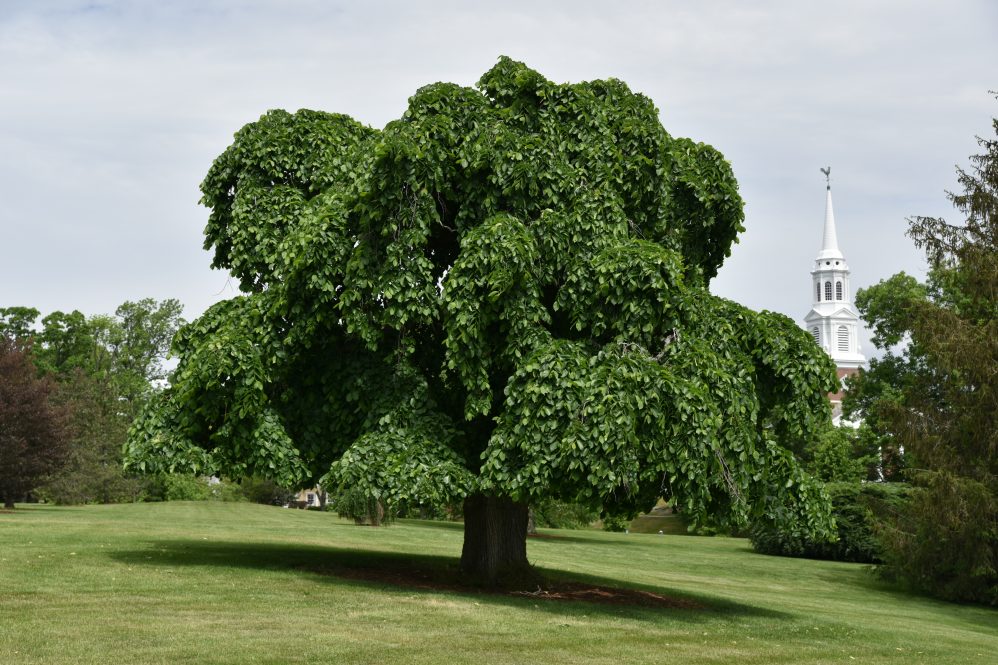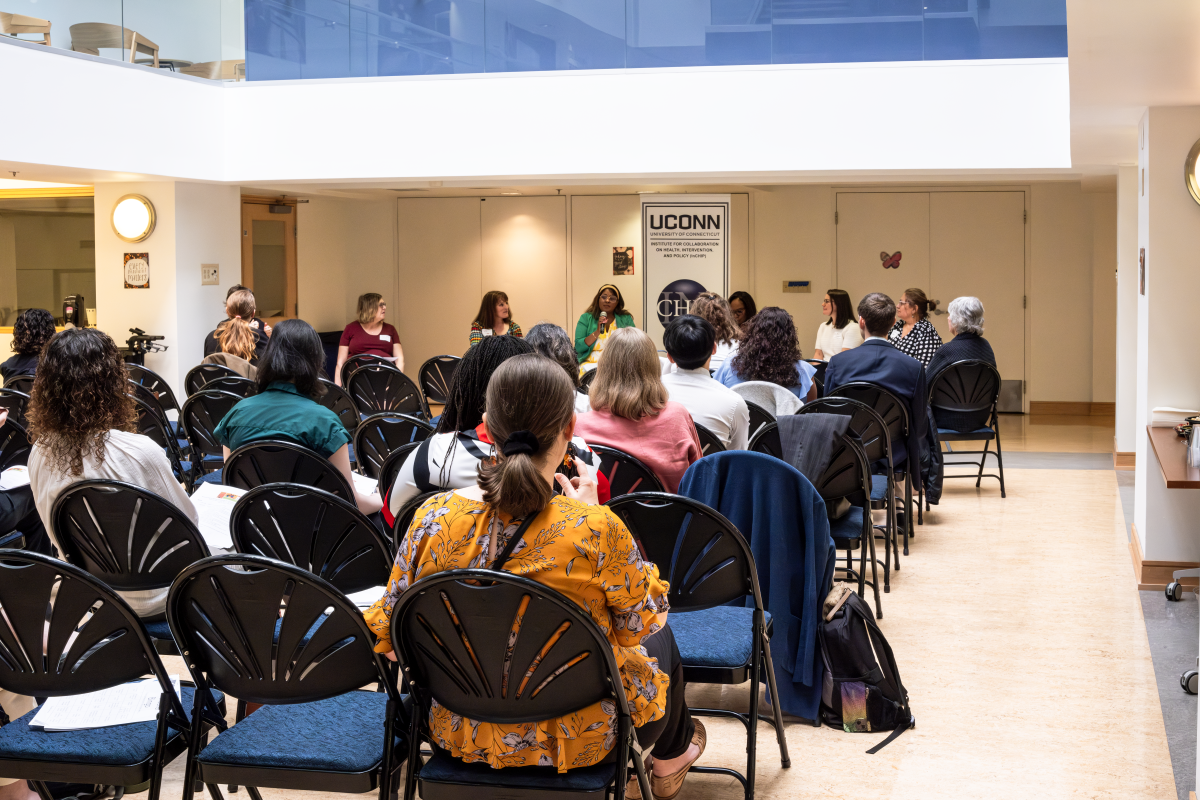As UConn’s new graduates prepared to branch out into the world this spring, they also put down literal roots in Storrs by planting the Class of 2022 commemorative tree and mapping two dozen previous class trees dating back to 1895 that are still growing on campus.
The University’s longtime class tree tradition trailed off at one point in the 20th century, but was revived with the Class of 2019 and has continued each year since, even during the COVID-19 pandemic in 2020, when classes and most University operations were remote.
This year’s class tree, a three-flowered maple (Acer triflorum) native to China and Korea, was planted April 20 between Storrs Hall and the Wilbur Cross Building as part of the annual Earth Day Spring Fling celebration. The maple is expected to grow to about 25 feet high, and was one of three species of underrepresented trees that UConn seniors picked in a survey.
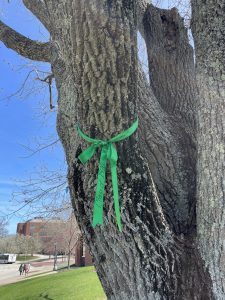
As they planted that tree, UConn seniors, faculty members, and others involved in the initiative were just a short walk from many of the other class trees planted during the institution’s history, including two from the 1890s.
This year, student interns in the Office of Sustainability located all 25 class trees on campus and adorned them with green satin ribbons reflecting the year they were planted – at least one from every decade between the 1890s and the 1940s, plus 2019 through this year.
The ribbons had to be removed after Commencement because they cannot withstand the elements over time, the University also posted a map on the sustainability office’s site to help students, alumni, nature lovers, and others visit any or all of the trees at their leisure.
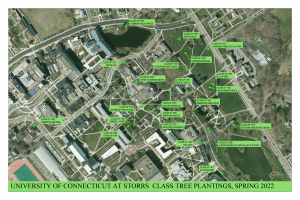
“The class trees are something that really links people to the campus, and to the students that were here before them,” says Gregory Anderson, Distinguished Professor Emeritus of ecology and evolutionary biology, and co-chair of the UConn Arboretum Committee.
“When you talk with people who’ve spent time at UConn, a lot of people feel a great affection for the trees where they’d sit and talk with others, or where they’d study or spent time,” Anderson says. “The trees feel like a piece of campus that continues into the indefinite future, even longer than the buildings in some cases.”
UConn Senior Sustainability Program Manager Patrick McKee agreed: “I envision alumni returning to campus and visiting their class tree, sitting with it, and taking pictures of it with their family. As they grow, so does the tree. It’s a wonderful tribute to their time as a student and place for reflection.”
The UConn Storrs campus is an arboretum in itself due to the number and variety of trees planted over the years on its acreage, many of which are unusual species that aren’t native to the area and were specifically selected to add diversity and beauty.
As Connecticut’s first higher education institution to be named as a Tree Campus USA by the Arbor Day Foundation, UConn has detailed plans to care for the 5,096 trees identified as currently existing on its Storrs campus.
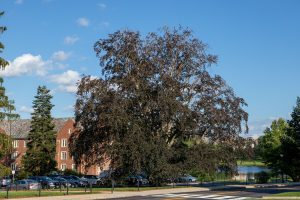
Of those trees, 181 are considered notable either because they are memorial trees; uncommon species or state champion trees due to their size or other attributes; or trees on UConn’s self-guided tree walk. The University often also identifies additional trees as notable examples if they are the only representative of the species on campus, or the largest or most mature.
The Arboretum Committee monitors UConn’s trees along with the Office of Sustainability, Facilities Operations and Maintenance, and other individuals and departments at the University.
Of the known 25 class trees that still exist at UConn Storrs, the oldest still standing was planted in 1895, about 14 years after the institution was founded as Storrs Agricultural School.
That tree, a large Camperdown Elm (Ulmus glabra ‘Camperdownii’), survived the Hurricane of 1938 and sits at the northwest side of the Great Lawn where it was transplanted. A close look at the trunk about four feet from the ground shows where the tree was grafted to the upright root stock of another elm species.
The tallest tree on campus is also the legacy of another long-ago graduating class: A tulip tree (Liriodendron tulipifera) near Beach Hall and the Great Lawn. Planted by the Class of 1905, it now has a circumference of more than 13 feet.
Although most of the class trees are located in the historic campus core and periphery, the London Planetree (Platanus x acerifolia) planted by the Class of 1938 is located on Hillside Avenue across from the Jorgensen Center for Performing Arts.
Coincidentally, many of UConn’s trees were battered or destroyed later that year during the Hurricane of 1938. The waterlogged ground offered no resistance for their roots, resulting in widespread damage as many toppled altogether.
Student volunteers tabulated 1,762 campus trees of 42 species that were destroyed, including a grove of oaks estimated at more than 200 years old. Some even had sea salt on them from Long Island Sound.
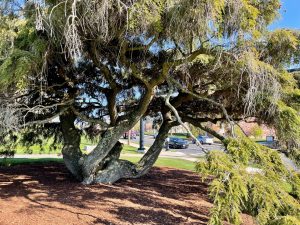
Many faculty, students, and staff joined in the coming decades to help locate and plant more trees and other greenery, notably the late Kenneth Bradley, a professor in the Department of Plant Science. He was particularly involved throughout his time as a UConn faculty member from 1947 to 1977, working with others to procure rare trees from arboreta and other sources worldwide to plant on campus.
In fact, this year’s students aren’t the first to think of marking previous years’ class trees.
In May 1965, Bradley and students in the UConn Horticulture Club marked 70 trees and shrubs – including the 24 class trees still on campus at that time — by driving stakes in the ground near them with plastic labels identifying their species, the class that planted them, and other details.
At that time, the oldest class tree was an American elm planted in 1892 near the Grange Memorial, also known as the Stone Pavilion. Like the ribbons used to temporarily mark the trees in this year’s project, the wooden stakes didn’t last; it’s not known when they were removed, and when the 1892 tree either fell or had to be removed.
However, as that effort and this year’s initiative showed, the annual class plantings do more than celebrate each year’s graduates. They also spread the word about the unique tree population on campus and help achieve UConn’s goals for a succession plan to ensure there are many healthy trees on campus as older mature trees decline in health or become hazards.
The class tree project is managed as part of the Campus Beautification Fund at the UConn Foundation. To donate to the fund, visit this link.
